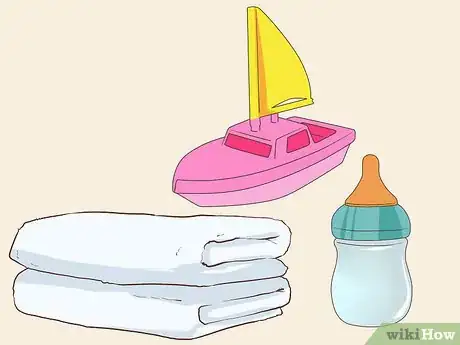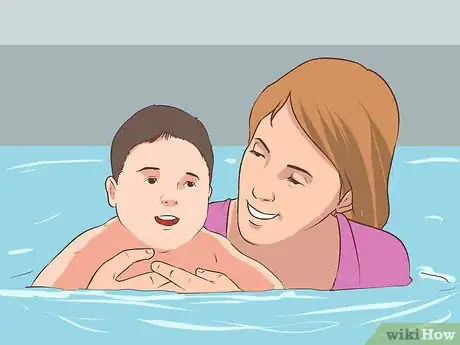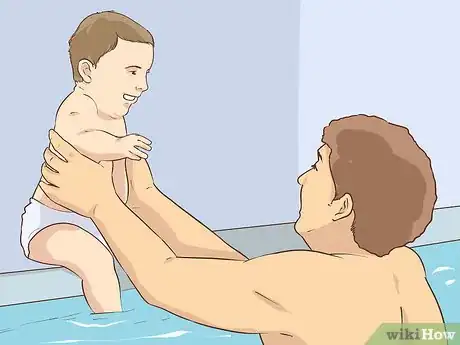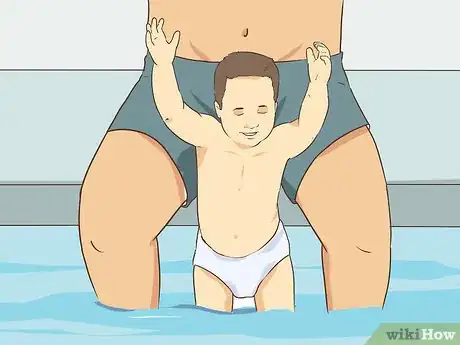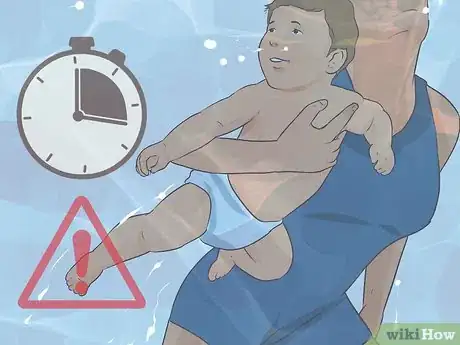This article was co-authored by Laura Marusinec, MD. Dr. Marusinec is a board certified Pediatrician at the Children's Hospital of Wisconsin, where she is on the Clinical Practice Council. She received her M.D. from the Medical College of Wisconsin School of Medicine in 1995 and completed her residency at the Medical College of Wisconsin in Pediatrics in 1998. She is a member of the American Medical Writers Association and the Society for Pediatric Urgent Care.
There are 9 references cited in this article, which can be found at the bottom of the page.
This article has been viewed 41,682 times.
Bringing your baby to the pool can instill healthy and safe practices early in their life. Babies can start going into the water at six weeks, although you should make sure that they are ready before you begin. At the pool, you should introduce the baby slowly and safely. Once you are in the water, you can make it fun by playing and singing. Over time, your baby will become more comfortable and confident in the water.
Steps
Getting Your Baby Ready for the Pool
-
1Start with baths. Before you introduce your baby to the pool, you can familiarize them with water through baths. While they bathe, fill a cup with water and slowly pour it over their head. This will teach your child what it is like to be wet. Always supervise your child while they are in the bath.[1]
-
2Consider when you want to begin. The earlier you expose your baby to the pool, the more confident they will be as a toddler in the water. You can start as young as six weeks old. Do not worry about introducing them too young. Babies up to six months old actually have a natural instinct to hold their breath under water. [2]
- For young infants, you should make sure that umbilical cord or circumcision wounds have healed.[3] Furthermore, if you had a C-section, you may want to wait until you have healed as well.[4]
- You can wait until your baby is older if you want. Babies between six and ten months can be taught to hold their breath on cue. They may also be able to grab the edge of the pool or push off the side of the pool into your arms.[5]
- Speak to your doctor to make sure that your baby is ready to go into the pool. The doctor can tell you if an infant's wounds have healed or if there are any medical conditions that may prevent your baby from going into the water.
- Also avoid bringing your baby to a public pool if they have any infections such as skin, respiratory, or gastrointestinal.
Advertisement -
3Pack baby supplies. You will need to pack your diaper bag with certain supplies to make sure that your baby is comfortable and happy. The most important thing to bring are swim diapers. These will catch any accidents that happen in the pool. Many public pools require that babies wear swim diapers. You should also bring:[6]
- A bottle or snacks if your baby is at that stage
- A clean towel or two — one with a hood is best
- Bath toys such as toy boats, plastic animals, or dolls
-
4Find a suitable pool. You can start in a public pool, a private pool, or an inflatable baby pool. The pool should be warm and clean. For babies under six months, the water should be heated to 90°F (32°C).[7] [8]
- If you cannot find a heated pool, you can take them into a non-heated pool. Your pool session should only last 10 minutes. Afterwards, warm the baby up in a clean towel.[9] If the pool feels too cold for you, it is too cold for your baby.
Practicing Safe Pool Habits
-
1Make sure lifeguards or instructors are available. If you are using a public pool, you should ensure that there are lifeguards on duty. If something bad happens, they can help rescue or resuscitate your baby.
- You may even want to consider baby swimming lessons. The instructors will be experienced in introducing babies to pools, and they will have proper safety equipment.[10]
-
2Hold your baby tightly. Enter the pool with your baby pressed against your chest. Go slowly so that you do not shock your baby. Once you are in the water, hold your baby under the armpits. Make sure their head is above water and that their face is level with yours.[11]
-
3Supervise your baby. You should always be holding your baby in the pool, even if they are just playing on the steps. Never take your eyes off of them. Even if you are starting in a shallow baby pool, always watch your baby. If they fall over, they can inhale water and drown. Sit in the pool next to them or on the steps with them between your legs.
-
4Avoid relying on flotation devices. Water wings, air-filled tubes, and kick boards will not guarantee that your baby will be safe. Some experts recommend against using these as they may cause more harm than good.[12] Instead, keep a firm grip on your child while they are in the pool. If you want extra reassurance, find a U.S. Coast Guard approved baby life vest.
Getting Used to the Water
-
1Play with your baby. Once you and the baby are in the water, you should start playing and singing to them. Smile and relax. This will help your baby adjust to the water, and they will associate it with pleasant emotions.[13] You can try to:
- Gently bob your baby up and down in the water.
- Gently swirl them back and forth in the water.
- Float some bath toys in the water. As they reach for them, hold your baby out horizontally in front of you as though they are swimming. Do not let go of them. Make sure that their head is above water.
-
2Let the baby splash on the steps. If there are steps in the pool, you can sit down with your baby sitting between your legs. Keep the baby upright. They can splash in the water or play with bath toys.
-
3Avoid staying too long. Babies can become cold in the pool, even in a heated pool. At first, you should only have a session of about 10 to 20 minutes. You can work your swimming sessions up to 30 minutes, but this is the maximum time limit for most babies.
- If you notice your baby’s lips or fingernails becoming blue, they are cold. Similarly, if they begin to shiver, you should remove them from the pool. Dry them in a towel to warm them.[14]
-
4Remove the baby if they are upset. If the baby cries or shows other signs of distress, get out of the water and try again later. Wrap them in a towel to dry them off. You may want to wait a few weeks before trying to introduce them again.[15]
Warnings
- Take your time. There is plenty of time to get them used to being in the pool.⧼thumbs_response⧽
- Always supervise children and babies in the pool.⧼thumbs_response⧽
- Do not let go of your baby until they learn how to swim.⧼thumbs_response⧽
References
- ↑ http://www.parents.com/baby/care/american-baby-how-tos/introduce-baby-to-swimming/
- ↑ http://www.babycentre.co.uk/a539332/swimming-with-your-baby
- ↑ http://www.parents.com/baby/care/american-baby-how-tos/introduce-baby-to-swimming/
- ↑ http://www.babycentre.co.uk/a539332/swimming-with-your-baby
- ↑ https://babyswimming.com/what-babies-can-learn/
- ↑ http://www.babycentre.co.uk/a539332/swimming-with-your-baby
- ↑ http://www.parents.com/baby/care/american-baby-how-tos/introduce-baby-to-swimming/
- ↑ http://www.parents.com/baby/care/american-baby-how-tos/introduce-baby-to-swimming/
- ↑ http://dailymom.com/nurture/how-to-introduce-your-child-to-a-swimming-pool/
- ↑ http://www.babycentre.co.uk/a539332/swimming-with-your-baby
- ↑ http://dailymom.com/nurture/how-to-introduce-your-child-to-a-swimming-pool/
- ↑ http://www.momtricks.com/babies/introduce-baby-to-swimming/
- ↑ http://www.parents.com/baby/care/american-baby-how-tos/introduce-baby-to-swimming/
- ↑ http://dailymom.com/nurture/how-to-introduce-your-child-to-a-swimming-pool/
- ↑ http://www.parents.com/baby/care/american-baby-how-tos/introduce-baby-to-swimming/
About This Article
You can start introducing your baby to the pool when they’re as young as 6 weeks old. To get your baby used to being wet, have them take baths in a shallow tub and gently pour water over their hair. When you’re ready to hit the pool, bring supplies like towels, baby sunblock, and a few pool toys. Babies get cold easily, so stick to a heated pool with water that’s around 90° F, and don’t stay for more than about 10-20 minutes. Keep the experience fun by playing with your baby, and take them out of the pool if they start to get upset. For safety, always supervise your baby closely and hold onto them while you’re in the water. For expert tips on how to get your baby used to being in the pool, keep reading!


